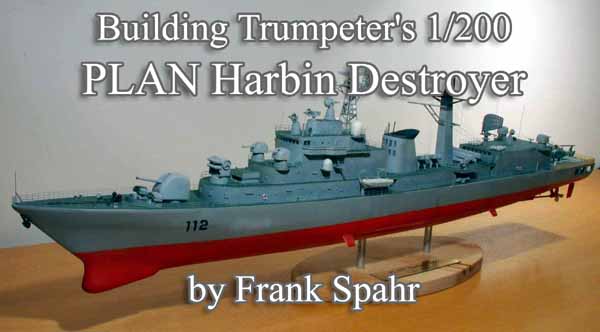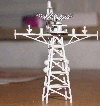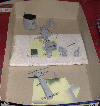

| Hi all, my name is Frank and I'm a ship
modeler by heart. I've built lots of aircraft and I love them, but ships
intrigue me in a special way. I've only built a few of them over the last
years, mostly due to space constraints and my intent to get practice in
all the various techniques I´d like to master and am slow to learn.
But such a complex thing as a ship has a very special appeal to me. I still
possess Revell´s 1/96th USS Constitution and Alabama, built when
I was 17 and 28 respectively, and the new kits and techniques I've discovered
on the net over the years have made me itch for building a modern warship
even more.
The introduction of Trumpeter's Sovremenny class destroyer and WEM´s etch parts for it made that itch even worse, and I decided to do something, in spite of the backlog of kits in the cellar. So one day I happened upon the older Trumpeter 1/200th scale kit of a Chinese destroyer, offered for little more than a song on E-bay. I got it and decided to use it as a test bed for techniques of improving a kit before progressing to the Sovremenny (which I still intend to do). I got the kit in August of 2003, wrote a preview and got started a little later. Being rather lazy in these matters I didn't write a building log, which I now regret, as I can only go by my photos taken during the build to retrace what I did. Now modern warship modelers include some of the most gifted guys I can
imagine. Seeing the work displayed on this site just took my breath away.
Especially those guys that rig tiny ships in 1/700th scale with dozens
of gossamer-like thread and even man them with figures, which must be about
a millimeter tall make me feel very small. Now that is far beyond my abilities,
so I felt happy with the larger scale. I did some googling on the Harbin
and found a set of pictures, mostly taken during a fleet visit to U.S.
Waters. But there wasn´t really a lot of references readily available.
But you could see some details, and man what a lot of detail a modern ship
has! I quickly realized how simplified this kit was and easily envisioned
the Chinese dad with his son sailing this model with a simple remote control
on a pond (the pond probably populated by ducks destined to become crispy
#54 one day). The instructions showed how to install a simple R/C. Much
was simplified in order to get the thing to float and make it more sturdy
in handling. So the stern bay was only hinted at and sealed with transparent
styrene, and the railings were way oversized. I decided to improve whatever
came into my mind and see where it took me.
|
|||||||||||||||||||
| So I started with cleaning up the hull. It had rather prominent mold seams, and I sanded those away. I also gave thoughts to a new stand. The one from the kit didn´t appeal to me that much. In the end, I hot glued a sturdy piece of wood into the hull and drilled two 8 m/m holes through the entire assembly. Into those I fit pieces of aluminum tubing and mounted them on a stand that I hot glued from wood. So I could handle the model quite easily and securely. During the end of construction I took a piece of birch wood (a breakfast plate from IKEA) and sawed an oval shape out of it, drilled fitting holes into that, sanded it and applied wood oil. That gave me a nice stand and I had a nameplate made at a shop specialized on trophies and signs. | Click images
to enlarge |
||||||||||||||||||
 |
|||||||||||||||||||
 |
|||||||||||||||||||
| Work on the hull continued with attempts at bringing some structure into it. A ship´s hull will always show the framework below the hull plates, just like the stressed-skin surface of an airplane. So I used my modeling knife to produce some patterned grooves and dimples in the surface. The effect didn´t satisfy me, but I couldn´t come up with a better way at the time, so I played around a bit during painting the hull with shadings. I had decided to use Revell 76 for the shade of grey (I've no idea which exact shade the People´s Liberation Army´s Navy uses, and frankly I'm heretic enough not to care) and used several lighter and darker shades to bring some more definition to the hull. I also decided to paint the decks green (as per instructions), and I used Humbrol 30 on them. The reference pictures showed the decks to be rather dark grey than green, but I used the green paint nonetheless because I liked the looks better that´s just me, folks. The numerous holes for the kit railings were filled at this stage, too prior to painting. |  |
||||||||||||||||||
 |
|||||||||||||||||||
| The rudder and propeller assemblies were cleaned up (the
propellers are made from some non-styrene plastic and were a bit tough
to work on), mounted under the hull, filled and sanded. Then I looked up
whether the original ship has a waterline marking or not, and the pics
seemed to indicate to me that it hadn´t, so I only used red and grey
on the hull. I still have no idea how to weather a hull below the waterline,
so I didn´t. Will have to look up pics of ships in drydock to determine
the best way.
Next came the stern bay. In the original ship it houses a towed sonar device called a VDS (Variable Depth Sonar), a thing looking like a blimp airship or a barrage balloon. That was present, but not the deck and surroundings. So I made those from evergreen styrene and mounted it into the ship´s stern. That done, I mounted the deck pieces which I had painted beforehand. |
 |
||||||||||||||||||
 |
|||||||||||||||||||
| The fit was generally OK and didn´t pose big issues. So now the hull with the deck was nearly done. I used the kit decals for the helipad, but not the hull number decals, as those were white instead of black as in the references (you see, I can also heed references if I'm in the right mind...) So I used the decals as templates and cut a paint mask for the numbers which I then sprayed. I used the leftovers of some clear adhesive sheet I had obtained years ago. The stuff is sturdy and a bit forgiving. The anchors were weathered modestly and mounted at that stage. I still haven´t decided if I´ll make them rusty with a new 2 component stuff from the Armor scene I've bought. It´s probably like some other products in that you have a paint that contains iron particles and a second component that will corrode the iron in the paint. You have to paint the appropriate areas with #1 component, let it dry for ten hours, and then apply #2 component and let the acid in it work. I've seen very nice results and will keep you posted on my next (cough!) armor project. | |||||||||||||||||||
| The hull done, I started with the various deckhouses and radar's and gun turrets and the dozens of other subassemblies. I decided for each separate thing how far I had a mind to go and tried my best. |  |
||||||||||||||||||
| It was at that point that I began using the PE sets I had
bought for this kit. Now there is no dedicated PE set for this kit. I also
didn´t mean to cannibalize the very expensive WEM set for the Sovremenny,
and I found nothing much else in 1/200th scale. Most ship models are either
in 1/350th or even 1/700th. After some searching I found PE in 1/250th
made for cardboard models by the german company HMV. They had generic railings
and also some generic fittings including ladders and handwheels and lots
of other tiny stuff. I decided to use this stuff as it would be a bit too
small in the worst case and be affordable. Measurements on the kit railings
showed them to be 6 mm tall whereas the 1:250 ones are 5 mm. I can live
with that, and I hope that not too many kit sailors go overboard ...
And yet in buying them I easily spent twice what I paid for the kit originally (it´s even worse with the Revell S-100 Schnellboot, as I've bought WEM stuff there ...) I used the PE here and there in detailing, where I found it handy, but most work was done with hobby knife, drill bit, dremel, stretched sprue and Evergreen. At times I had several dozens of subassemblies lying in a box in various stages of progress. I replaced the barrels of the main guns (130 mm) by aluminum tubing and opened the other barrels with a hot needle. Quite a lot of work went into the radar's, first by cleaning them up and trying to make them more realistic. I added some stretched sprue framework at the main radar and tried to duplicate the radar dish with wire mesh. Another challenge was the funnel: I improved the exhausts and replaced them with metal tubing; the very prominent cooling grills were sawed out and replicated with wire mesh. I also added some wire antennas in the end the funnel took some hours of work.
|
|||||||||||||||||||
| I'm always concerned about styrene masts and yards stability
wise, and try to replace them wherever it makes sense to me. So I remade
the prominent yard in front of the ship´s aft mast from brass rods
which I soldered together.
The various bulleyes and windows are only hinted at in the kit, so I drilled out the first and sawed out the latter, adding new frames from brass or styrene where possible. To me the bridge windows of a ship are its face, and when I opened them up the ship started coming to life. There´s also a row of windows at the bow side of the hangar which I tackled at that point. |
|||||||||||||||||||
 |
|||||||||||||||||||
| I had looked up pics of the ship´s helicopter and detailed mine accordingly. I drilled out all the windows and filled them with Kristal Kleer after painting. I also made new rotor blades from thin styrene, thinned out the stabilizers and added exhausts from metal tubing. I added some scrap decals and I was done. |  |
||||||||||||||||||
 |
|||||||||||||||||||
| Painting the superstructures involved several back-and-forthing
due to overspray, but in the end I was where I had wanted to arrive at.
I completed the deckhouses separate from the kit as far as made sense to
me and only assembled when I felt it was OK.
All this took place over the entire year 2004 with many interruptions. My modeling room was cleaned out when a new heating was installed, that alone took some six weeks in all but now I've got much more space to clutter! I also built some other smaller projects in between. And I had to obtain brass anchor chain. The PE chain in my generic PE set wasn´t the real deal. So it took several months and some trips to the only shop in Kassel that could provide the stuff until I had it. Meanwhile I know another shop, thankfully. But the lack of the chain was of course a great (and lame) excuse not to continue on the project ever played those little cowardly games yourself, anyone? |
 |
||||||||||||||||||
 |
|||||||||||||||||||
| All the while, the Harbin sat on the shelf, gathered dust
and waited for me to summon my guts to continue on her. My main concern
were the PE railings. I had asked questions on the modelwarships.com forum
and other places and got good advice (thanks Guido, Frank and Rick!) but
was really scared of the process I know I have a talent of buggering
things on the very final leg of a project.
In the end (in December) I actually got started and the whole process went nearly like a breeze. I had bought a big magnifying light in spring. Without that, I just can´t model any more, and surely it wouldn´t have been possible for me to work with the PE without it. I could actually see what I was doing at any given moment and felt I had some control on the process. The HMV PE is very fine and easy to work with. I used both more and less viscous CA glue, but in the end, the less viscous sufficed. I had found some CA applicators in my practice from the time I used a CA-based dental material, and they were just great for applying the CA. I attached the piece of railing at a point and worked from that on, applying droplets of the stuff until everything was firm. Clipping was done with a 9X X-ACTO on a glass plate and with small bent and straight scissors. The whole affair had been sprayed grey prior to working with it, and I used tweezers and appropriately rounded pencils or knives as templates for curving and bending it. There are some curves and bends in the railing, and although not perfect, I was rather happy with the results in the end. I also rigged the ship at that stage. I just felt overwhelmed by the pics with those myriads of lines runing hither and thither. In the end, I looked at several pics of other models and rigged what I thought looked nice and might even make some sense. For rigging, I used ultra-fine copper wire from model railroad wires. The single copper strands are very thin - yet much tougher than sprue. I could even make knots and otherwise secured them with CA. Later on they were painted. Murphy´s law struck when I was nearly through: I had started with the 2-bar railing on the superstructures and intended to use the 3-bar only on the main deck level (it might just as well be correct the other way round ...). So far so stupid. In the end, I lacked about two pieces of 2-bar railing to complete the tour around the ship on the first floor, so to speak. So I had to order another PE fret at another 23 EURO. I should have measured better in the first place, and now I might build yet another destroyer, railingwise. When the additional fret had arrived, I completed work on the upper levels. On the main deck, I used the 3-bar railing. To simulate the netting or canvas or whatever is sewed to the railing around the helipad, I used Kristal Kleer. It might just as well look completely different in reality, but I fashioned it somehow the way the kit parts were, just finer. After drying I sprayed it lightly with Humbrol radome tan from the inboard side, so that the color shone through and you could still see the grey railing frames from the outside. Installing the remaining railing (once around the ship) took about an hour. Then it was time to do a tour around the ship for paint touchups this
way and that. After that I used Flat Future (Future and Tamiya Acrylic
Clear Flat Base) to give the ship a flat coat and hide the gloss areas
from the CA glue. Now this works really very fine for me and it´s
my favorite final coat currently. And really, really finally I filled the
windows and bulleyes with Kristal Kleer and let that dry to give the impression
of glass windows.
|
|||||||||||||||||||
| I personally recommend this kit for people who would like
to have fun improving it. It´s no shake and bake and it´s not
correct, but that´s not where my objectives were. I don´t have
a meager share of the vast knowledge of many great modelers, but I'm happy
with what I do at this point in my life. After all life´s a journey,
and why not travel part of it by boat.
I only found one webpage of a built-up model of this kit, by a German R/C modeler who did a great job: And here´s a very nice model of the Harbin´s successor, the Zhenzhen, built for nearly the same reason as I built mine. |
|||||||||||||||||||